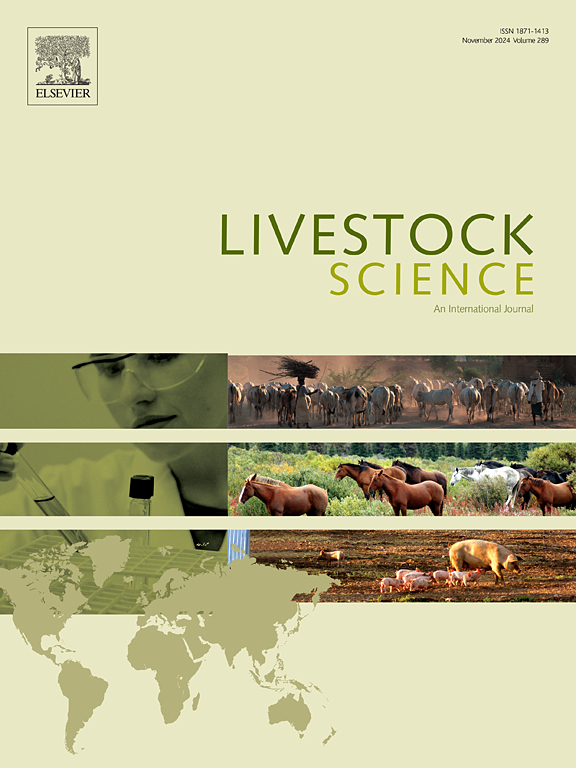温带中季牧草的氮肥施用量:肉牛的消化、氮平衡和瘤胃微生物群以及体外瘤胃发酵和甲烷产生
IF 1.8
3区 农林科学
Q2 AGRICULTURE, DAIRY & ANIMAL SCIENCE
引用次数: 0
摘要
牛排泄的氮(N),尤其是尿氮,会对空气和水质造成不利的环境影响,并导致温室气体排放。研究了夏季将无机氮肥的施用量从每公顷每刀 15(N15)千克提高到 80(N80)千克对肉牛的摄入量、瘤胃发酵、瘤胃微生物种群、表观总消化率和氮平衡以及体外发酵和甲烷输出的影响。在随机区组设计实验中,16 头夏洛来(Charolais)乳牛在施用氮肥 21 天后食用机械收割的鲜草。类似的青草在一个由八个容器组成的离体 RUSITEC 系统中进行培养。与 N15 相比,N80 的草粗蛋白浓度每千克干物质 (DM) 高 50 克。不同处理的草DM摄入量没有差异。瘤胃发酵变量在不同处理之间没有差异,除了N80的摩尔比例高于N15。瘤胃中总的微生物群落结构并未因无机氮肥施用量而发生显著变化。在较高的氮肥施用量下,Lachnospiraceae_NK3A320_group 和 Ruminococcaceae_NK4A214_group 以及 Acetitomaculum 等单个菌属的相对丰度明显较低。与 N15 相比,N80 的平均血浆尿素浓度更高。DM、有机物、中性洗涤纤维和酸性洗涤纤维的体内消化率不受氮肥施用量的影响。N80 比 N15 的氮摄入量高 75 克/天,尿氮和粪氮排泄量分别高 20 克/天和 5 克/天。与 N15 相比,N80 的氮保留量和氮利用效率更高。N80 的体外 NH3 浓度高于 N15,而其他瘤胃发酵变量以及体外甲烷和总气体输出量在不同处理之间没有差异。降低中季温带牧草的无机氮肥施用量可减少肉牛的氮排泄量,对环境有益,但对体外甲烷产量没有影响。本文章由计算机程序翻译,如有差异,请以英文原文为准。
Nitrogen fertiliser application rate to temperate mid-season grass: Digestion, nitrogen balance and rumen microbiota in beef cattle, and rumen fermentation and methane production in vitro
Nitrogen (N) excretion by cattle, particularly urinary N, can have detrimental environmental impacts on air and water quality, and contributes to greenhouse gas emissions. The effects of increasing the application rate of inorganic N fertiliser from 15 (N15) to 80 (N80) kg/ha per cut to Lolium perenne dominant swards in summer, on intake, rumen fermentation, rumen microbial populations, apparent total-tract digestibility and N-balance in beef cattle, and in vitro fermentation and methane output, were studied. Sixteen suckler-bred Charolais steers, used in a randomised block design experiment, were offered fresh grass mechanically harvested 21-d after N fertiliser application. Similar grass was incubated in an eight-vessel in vitro RUSITEC system. Grass crude protein concentration was 50 g/kg dry matter (DM) higher for N80 compared to N15. There was no difference in grass DM intake between treatments. Rumen fermentation variables did not differ between treatments, except for the molar proportion of propionate, which was greater for N80 than N15. Gross microbial community structure in the rumen was not significantly altered by inorganic N fertiliser application rate. The relative abundance of individual genera Lachnospiraceae_NK3A320_group and Ruminococcaceae_NK4A214_group, and Acetitomaculum were significantly lower at the higher N application rate. Mean plasma urea concentration was greater for N80 compared to N15. In vivo digestibility of DM, organic matter, neutral detergent fibre and acid detergent fibre was unaffected by fertiliser N application rate. Nitrogen intake was 75 g/d greater, and urinary and faecal N excretion were 20 and 5 g/d greater, respectively, for N80 than N15. The quantity of N retained and N use efficiency was greater for N80 compared to N15. In vitro NH3 concentration was greater for N80 than N15, whereas other rumen fermentation variables, and in vitro methane and total gas output, did not differ between treatments. Reducing the inorganic N fertiliser rate applied to mid-season temperate grass reduced N excretion from beef cattle, which is environmentally beneficial, with no effect on in vitro methane production.
求助全文
通过发布文献求助,成功后即可免费获取论文全文。
去求助
来源期刊

Livestock Science
农林科学-奶制品与动物科学
CiteScore
4.30
自引率
5.60%
发文量
237
审稿时长
3 months
期刊介绍:
Livestock Science promotes the sound development of the livestock sector by publishing original, peer-reviewed research and review articles covering all aspects of this broad field. The journal welcomes submissions on the avant-garde areas of animal genetics, breeding, growth, reproduction, nutrition, physiology, and behaviour in addition to genetic resources, welfare, ethics, health, management and production systems. The high-quality content of this journal reflects the truly international nature of this broad area of research.
 求助内容:
求助内容: 应助结果提醒方式:
应助结果提醒方式:


